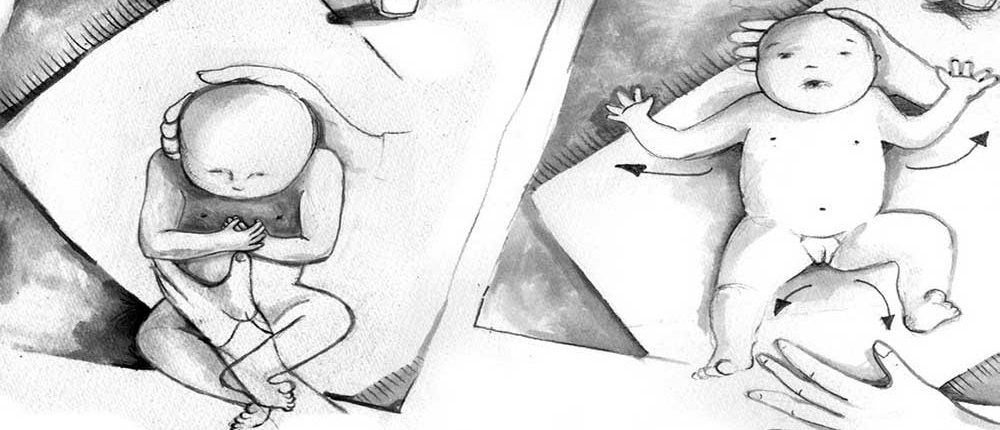Moro Reflex
Explanations of the Moro Reflex
The Moro Reflex begins development in the 28th week of pregnancy and should be integrated by the 4th month. The Moro Reflex allows the baby to breathe immediately after birth and straighten the body. It prepares the baby to hold the head in a vertical and horizontal position. The balance system becomes out of balance when there is a sudden change in position beyond the midline. The reflex pattern is a fear reaction but is not a clinging reflex. When the reflex is activated, adrenaline, and cortisol are released, which lowers immune defenses. An integrated Moro Reflex is the foundation for the development of the Landau Reflex and the tendon protection reflex.
The swaddling technique, increasingly recommended by physicians and pediatricians, can support the nervous system through this wrapping method from the first day of life and the newborn’s movement without stress hormones.
If the reflex is not fully integrated, the following abnormalities can occur:
Physical reactions of the Moro reflex
A divide between the upper and lower half of the body can be felt
Constant and unconscious state of heightened arousal
Dilated pupils
Reduced vision, glare effect
Auditory hypersensitivity, delay in auditory processing
Rapid fatigue during reading
Slow copying from the board
One-sided work coverage or deep bending of the head over work
Difficulty coordinating in ball games
Frequent infections, weakened immune system
Asthma, allergies
Typical candidates for ADD or ADHD
Psychological reactions of the Moro Reflex:
Fear and phobias
Increased disorientation
Strong defensive reaction, fleeing from oneself
Fight or flight reactions to new challenges
Insecurity due to changes
Mood swings
Oversensitivity, thin-skinned
Overstimulation and hyperactivity
Social consequences of the Moro reflex
Inability to build healthy relationships, more likely to seek guidance from others
Reduced learning ability
Limited decision-making ability
Need routine, predictability, and structure
Inability to concentrate
General stimulus-dependency, no ability to select, easily distracted
Low self-esteem
Tendency to control or manipulate situations
Origin: 28th week intrauterine
Duration: Birth to 3rd/4th month of life
Integration: 3rd/4th month of life
Reading through the list of abnormalities, it becomes apparent that many of these symptoms can also be observed in adults. This indicates that the Moro Reflex can still be active in adults. In middle age, this can lead to depression or sudden outbursts of anger.
The BalanceHIRO® exercises are suitable for helping adults integrate the Moro Reflex. Symptoms such as anxiety, discouragement, and indecisiveness will lessen as a result. Stress resilience will increase, a topic gaining more and more attention in the public sphere.
More interesting knowledge…
… about early childhood reflexes, as well as concrete exercises for subsequent integration and centering can be found in my course BalanceHIRO®.


